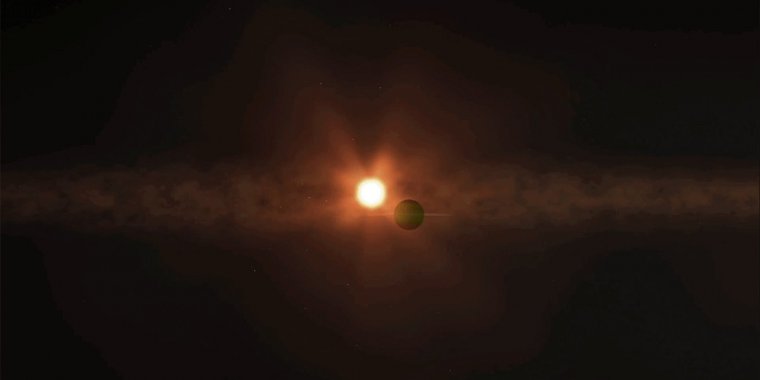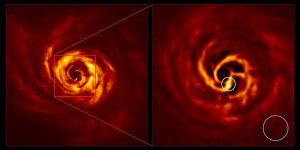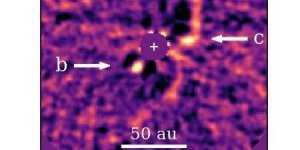| News / Space News |
NASA's TESS, Spitzer Missions Discover a World Orbiting a Unique Young Star
For more than a decade, astronomers have searched for planets orbiting AU Microscopii, a nearby star still surrounded by a disk of debris left over from its formation. Now scientists using data from NASA's Transiting Exoplanet Survey Satellite (TESS) and retired Spitzer Space Telescope report the discovery of a planet about as large as Neptune that circles the young star in just over a week.

This is an artist's concept of the planet AU Mic b and its young parent star. The faint band of light encircling the pair is a disk of gas and dust from which both the star and the planet formed. Credit: NASA's Goddard Space Flight Center/Chris Smith (USRA)
The system, known as AU Mic for short, provides a one-of-kind laboratory for studying how planets and their atmospheres form, evolve and interact with their stars.
"AU Mic is a young, nearby M dwarf star. It's surrounded by a vast debris disk in which moving clumps of dust have been tracked, and now, thanks to TESS and Spitzer, it has a planet with a direct size measurement," said Bryson Cale, a doctoral student at George Mason University in Fairfax, Virginia. "There is no other known system that checks all of these important boxes."
AU Mic is a cool red dwarf star with an age estimated at 20 million to 30 million years, making it a stellar infant compared to our Sun, which is at least 150 times older.
The star is so young that it primarily shines from the heat generated as its own gravity pulls it inward and compresses it. Less than 10% of the star's energy comes from the fusion of hydrogen into helium in its core, the process that powers stars like our Sun.
The system is located 31.9 light-years away in the southern constellation Microscopium. It's part of a nearby collection of stars called the Beta Pictoris Moving Group, which takes its name from a bigger, hotter A-type star that harbors two planets and is likewise surrounded by a debris disk.
Although the systems have the same age, their planets are markedly different.
The new planet, AU Mic b almost hugs its star, completing an orbit every 8.5 days. It weighs less than 58 times Earth's mass, placing it in the category of Neptune-like worlds. Beta Pictoris b and c, however, are both at least 50 times more massive than AU Mic b and take 21 and 3.3 years, respectively, to orbit their star.
"We think AU Mic b formed far from the star and migrated inward to its current orbit, something that can happen as planets interact gravitationally with a gas disk or with other planets," said coauthor Thomas Barclay, an associate research scientist at the University of Maryland, Baltimore County and an associate project scientist for TESS at NASA's Goddard Space Flight Center in Greenbelt, Maryland.
"By contrast, Beta Pictoris b's orbit doesn't appear to have migrated much at all. The differences between these similarly aged systems can tell us a lot about how planets form and migrate."
Detecting planets around stars like AU Mic poses a particular challenge. These stormy stars possess strong magnetic fields and can be covered with starspots - cooler, darker and highly magnetic regions akin to sunspots - that frequently erupt with powerful stellar flares. Both the spots and their flares contribute to the star's brightness changes.
Because the amount of light blocked by a transit depends on the planet's size and orbital distance, the TESS and Spitzer transits provide a direct measure of AU Mic b's size. Analysis of these measurements show that the planet is about 8% larger than Neptune.
For decades, AU Mic has intrigued astronomers as a possible home for planets thanks to its proximity, youth and bright debris disk. Now that TESS and Spitzer have found one there, the story comes full circle.
AU Mic is a touchstone system, a nearby laboratory for understanding the formation and evolution of stars and planets that will be studied for decades to come. (NASA)
YOU MAY ALSO LIKE





